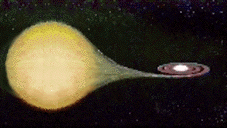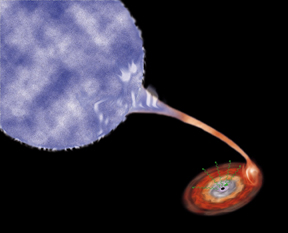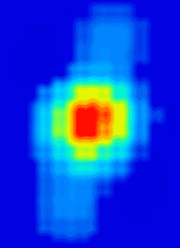RXTE Discoveries
Meet Our Neighbor, a Most Curious Black Hole - February 2000

|
Astronomers have stumbled onto the closest black hole yet, a mere 1,600 light years from Earth. And not only is it close, it behaves like no other black hole seen before. And not only is it strange, it was only detected by chance during a one-day eruption in X-rays in the constellation Sagittarius. This could be the first black hole that we travel to when we finally break free of our solar system. Or, to hear astronomers talk about it, it could be merely one stop on a visit to many of our black hole neighbors. |
"There might be many more black holes in the galaxy like this one waiting to be discovered," said Dr. Donald Smith of the Massachusetts Institute of Technology. "Chances are that this is not an oddity. Other objects may be just too faint and too fast for us to notice them."
| Smith and others at MIT identified the black hole with an X-ray satellite called the Rossi X-ray Timing Explorer (RXTE) and with some help from astronomers at the National Radio Astronomy Observatory. The discovery came when a star system called V4641 Sagittarius erupted in X-rays -- the telltale sign of a lurking black hole swallowing gas -- but then shut off as quickly as it began, which is extremely odd.
|
 |
As early as February 1999, astronomers knew V4641 Sagittarius was more than just a star. At that time, both U.S. and European astronomers using separate instruments detected a whisper of X-rays from the region. This suggested that there was likely one regular star orbiting around a collapsed star -- maybe a white dwarf, maybe a neutron star, maybe a black hole. No one could tell.
Things changed on September 15, 1999. The X-ray outburst seen that day occurred in such a way that Smith and his MIT colleague, Dr. Ronald Remillard, knew they had a black hole on their hands. By January 15, 2000, they had enough data to present this find in Atlanta before the largest gathering of astronomers, at the American Astronomical Society annual meeting.
There Goes the Neighborhood...
Black holes are invisible in any wavelength -- radio, optical or X-ray -- because their gravity is so strong that no light waves can escape. What we can see, however, is the fatal journey of gas spiraling onto the black hole at nearly the speed of light.
 | Hydrogen-burning stars, like the ones that dot the night sky, all glow in optical light. They also produce a few x-rays, but nothing so overpowering. When a normal star teams up with a black hole, though, things are different. The black hole can slowly pull gas away from the normal star. This gas heats up to temperatures millions of degrees hotter than when it was part of the star. The hot gas at this point glows big-time in x-rays, getting hotter as it gets closer to the black hole. The spiral of gas is called an accretion disk.
|
On September 15, the MIT folks saw this movement of hot gas near V4641 Sagittarius. The gig was up. One normal hydrogen-burning star like our Sun was orbiting around a "secret" dead, collapsed, highly compacted star -- and that collapsed object was a black hole. The x-rays gave it away.
Caught in the Act...
V4641 Sagittarius was a quiet system. For this reason, astronomers -- particularly X-ray astronomers -- couldn't gather much information about it. The optical light was too dim, and there wasn't much in the way of X rays. The "living" star was, perhaps, too far from the black hole, so the black hole couldn't steal much gas from it. No theft of gas, no X-ray light, and thus no observation.
But it seems the black hole got a little greedy. Without warning, V4641 Sagittarius "turned on." What Smith and his colleague, Dr. Ronald Remillard, witnessed on September 15 was nothing short of a crime in progress. It was as if a spotlight shone near the black hole. Gas was streaming onto the black hole and emitting copious amounts of x-rays.
Remillard said that many black holes are discovered this way. The black holes are "quiet" until suddenly there's enough gas backed up in the accretion disk to emit x-rays. Then it might get quiet again, and all X-ray astronomers can do is wait for the next flare, whenever that may be.
But V4641 Sagittarius' outburst was different. No known black hole ever shut down so abruptly as V4641 Sagittarius did, Remillard said. Usually the x-rays fade away over months or even years. V4641 Sagittarius flickered on and off like a light switch in a matter of hours.
Now you see it, now you don't; wait, now you see it again...
Smith was tuned in to V4641 Sagittarius after hearing reports that an amateur Australian astronomer spotted the star system glowing optically six times brighter than it had the night before, around September 14. Indeed, NASA's Compton Gamma-Ray Observatory had recorded a burst in high-energy x-rays that lasted a couple of hours and ended abruptly (although the Compton team didn't know of this until they went backed later and checked their data.)
Things were quiet for a few hours. Then a bigger X-ray flare came the next day. RXTE spotted this one. Smith saw the X-ray intensity rise by a factor of more than 1,000 in seven hours and then drop by a factor of 100 in two hours. Then that was it... sort of. Two hours later there was another burst almost half as bright as the previous one. Then nothing again. Then a little later, a 20-minute burst one-sixth as intense as the big one.
"Combining the data from all the instruments, we saw four of the most dramatic rapid X-ray intensity changes ever seen from one star," Smith said. "This behavior is new. We've never seen anything like it."
And it's quite possible, Smith added, that more bursts occurred between observations.
But Wait, There's More...
 The VLA, by Dave Finley, courtesy National Radio Astronomy Observatory and Associated Universities, Inc. |
Then there was the radio data, courtesy of Dr. Robert Hjellming of the National Radio Astronomy Observatory. Using the Very Large Array radio telescope in New Mexico, Hjellming spotted a jet of sub-atomic particles shooting away from V4641 Sagittarius at 90 percent light speed, three times longer than the distance from the Sun to Pluto. "Radio telescopes gave us a quick glimpse of something moving at a fantastically high velocity," said Hjellming. |
|
With the presence of radio jets, V4641 Sagittarius was behaving like a tiny quasar, Remillard concluded. Quasars are extremely distant galaxies with bright cores and jets of particles shooting out of either end. At the center of a quasar is likely a supermassive black hole, a region containing the mass of millions to billions of suns compressed into a space no larger than our solar system. Remillard said that V4641 Sagittarius is likely a "microquasar," behaving just like a quasar but on a much smaller scale. This black hole, after all, is only a few solar masses, not millions. There are only three known microquasars, none nearly so close to Earth as V4641 Sagittarius -- and none so odd.
|

|
"There's something fundamentally different about this one," said Hjellming. "It's more extreme than any other example."

| These three radio images, made from observations at the Very Large Array in Soccorro, New Mexico, show the activity of V 4641's jets on Sept. 16 and 17, 1999. The first image shows a jet shooting outward about 125 astronomical units -- three times the distance from the sun to Pluto. It moves at about 90 percent the speed of light on a path that is slightly inclined towards Earth. Just 30 minutes later, the jet had faded noticeably (center image). By the following day the intensity had dropped 40 times (right), but it remained for about three weeks until its signal faded into the background. Credit: Robert Hjellming, National Radio Astronomy Observatory
|
What makes V4641 Sagittarius so different? Smith and the gang aren't sure. Remillard speculates that the activity in the accretion disk in V4641 Sagittarius is much closer to the black hole than in other systems, or the black hole itself is significantly different in its mass, spin or charge from black holes in other systems. That's what they'll be trying to figure out next.
In the meantime, there's much cause for excitement. We have a nearby black hole, closer to us in the Milky Way than most stars. We have a rare example of a microquasar to study up close. And we have the sense that microquasars may not be so rare (or distant) after all.
All this from a neighbor that flicked its porch lights on and off for us.


